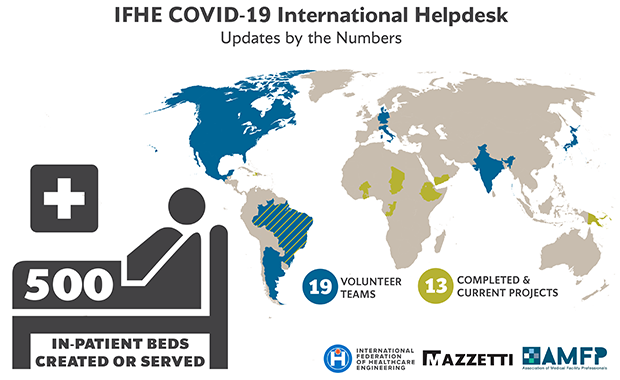For 29 years, Walt Vernon has served as CEO of Mazzetti, a mechanical, electrical, and plumbing engineering and technology consulting firm specializing in healthcare. Throughout his career, he’s pushed to evolve and improve the design of healthcare facilities, with this past year presenting new opportunities to contribute meaningfully.
A highlight of that effort was Vernon’s role in the COVID-19 response, during which he worked in concert with the International Federation of Hospital Engineering (IFHE) and Téchne, the World Healthcare Organization’s technical science for health network, to staff the “international help desk,” which provided healthcare facilities around the world pro-bono consulting and design services to help address the crisis. Vernon and volunteers from Mazzetti recruited 19 design teams that ultimately completed 13 projects so far, including converting an existing healthcare building for the care of COVID-19 patients in Burkina Faso and designing a prefabricated screening facility in Haiti.
He also led the ASHRAE Position Document on Infectious Aerosols, a work that disseminated evidence-based advice for managing threats from airborne pathogens in all types of buildings.
Additionally, Vernon saw the pandemic as an opportunity to collect much-needed electrical system data during healthcare surge events. Despite the challenging time, he was able to partner with seven hospitals in four states to have meters installed for a year to provide a better sense of electrical demand during a worst-case scenario event. The goal is to use the data to more accurately anticipate electrical demand in design going forward to achieve more sustainable and cost-effective operations.
In fact, sustainability and reducing the environmental impact of healthcare facilities are a longtime passion of Vernon’s. In 2020 he co-authored the National Academy of Medicine scoping paper on how to reduce healthcare carbon emissions over the next 10-30 years, outlining specific recommendations pertaining to health services delivery, infrastructure, and financing.
Guided by the belief that greater resiliency in healthcare is achieved by pursuing sustainability simultaneously, Vernon is also exploring the potential for the use of fuel cells and microgrids in U.S. hospitals to increase power resiliency while decreasing environmental footprint.
What do you love most about your job?
Being able to find new solutions to old challenges.
Who inspires you?
Nelson Mandela. He had the strength and wisdom to rise above the cruelty and injustice that had been inflicted on him and his people. He built a common vision for a country in which everyone was supported, no one punished and victimized. He was truly remarkable in human history.
What industry challenge do you hope to solve?
I’m trying to help the industry de-carbonize, and to show the rest of the world the public health imperative for doing so.
What’s the next major trend you anticipate for healthcare design?
True decarbonization … We need to intentionally design health service delivery to more aggressively embrace the central importance of carbon. This needs to come before we think about material elements; health service delivery is more fundamental.
What did you learn over the past year?
The power of inertia. Human beings are creatures of habit in almost all aspects of existence. As I try to create needed change, the resistance to that change is usually in the form of mental models rather than real change. For example, the hamster in the cage—once the cage is removed, it typically stays in the boundaries because it thinks the cage is still there. We have similar mental models. We have to figure out how to break mental models and actually change.












